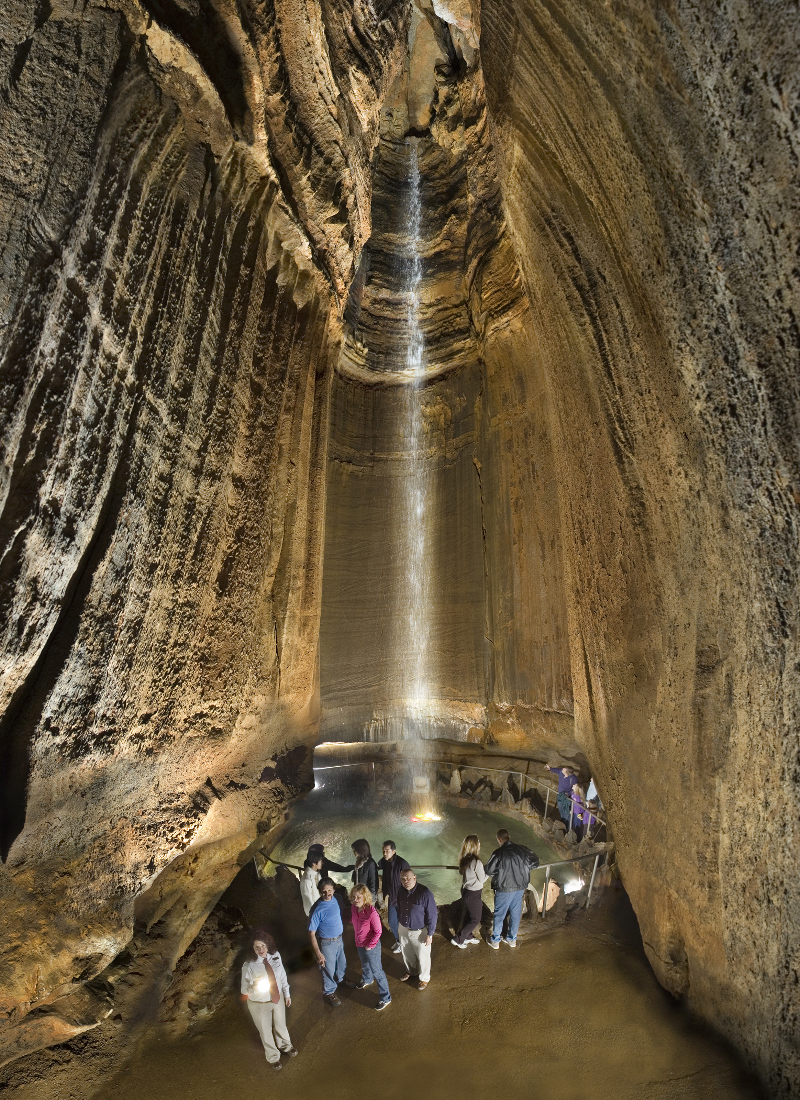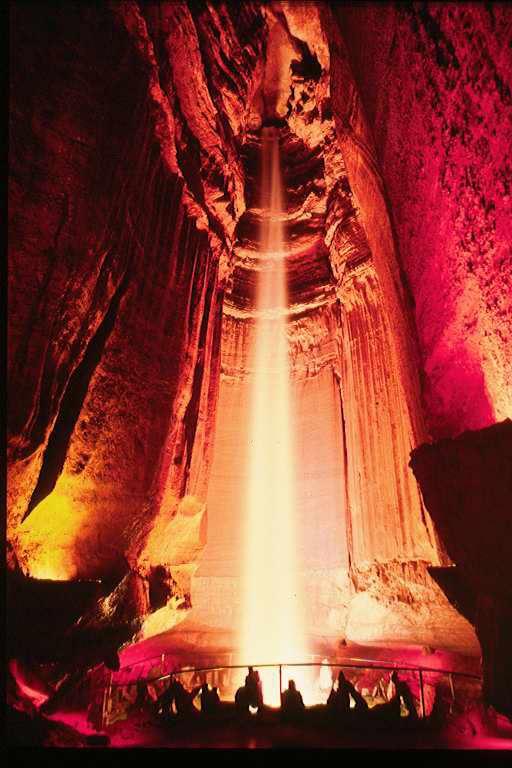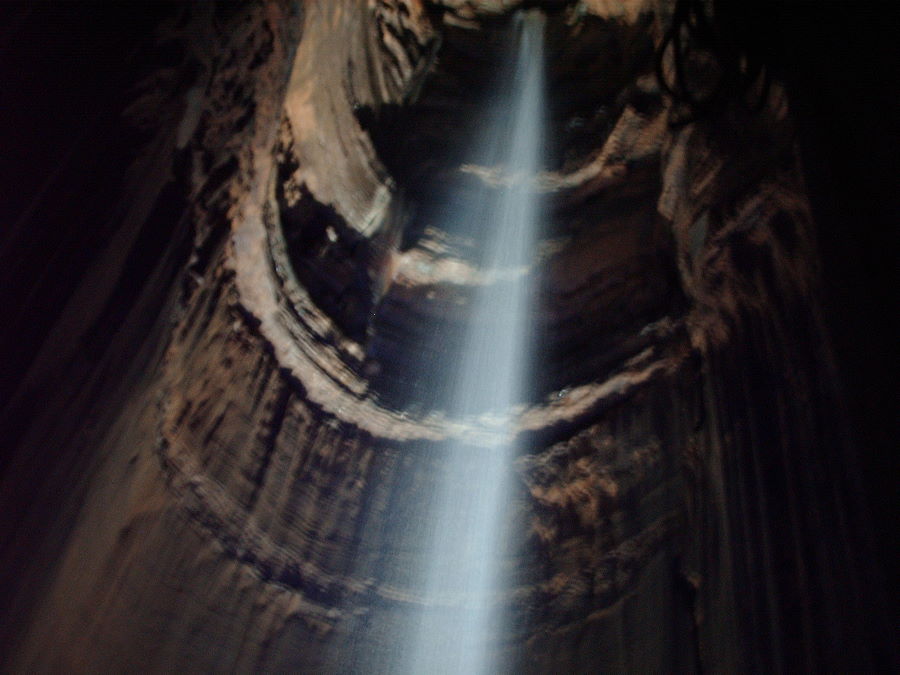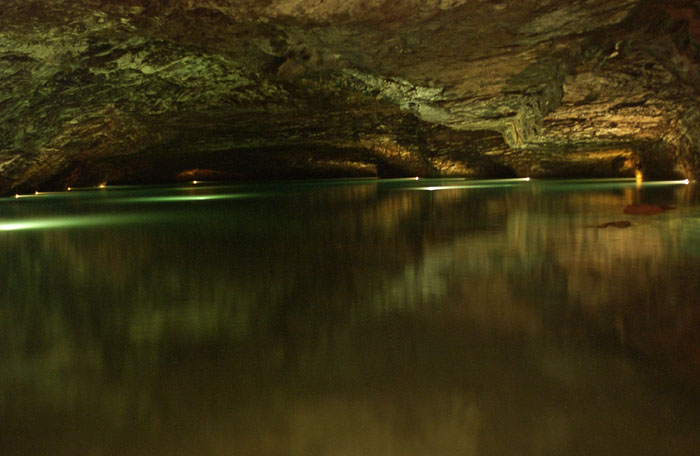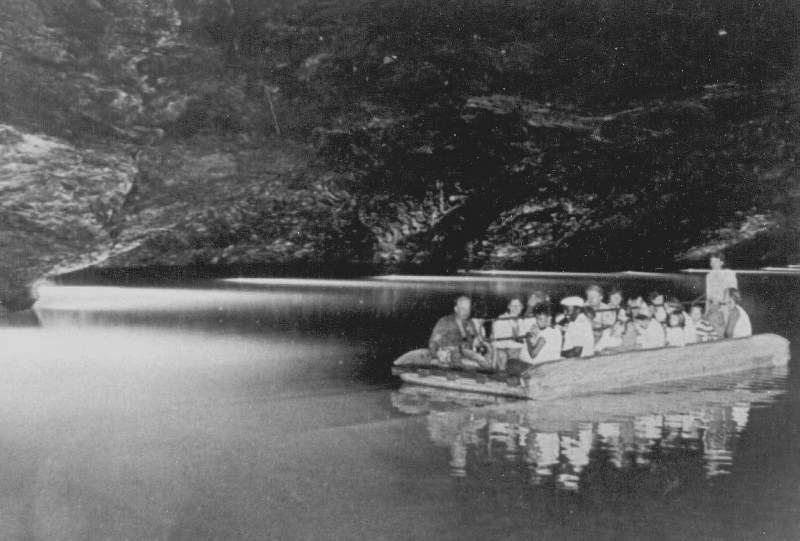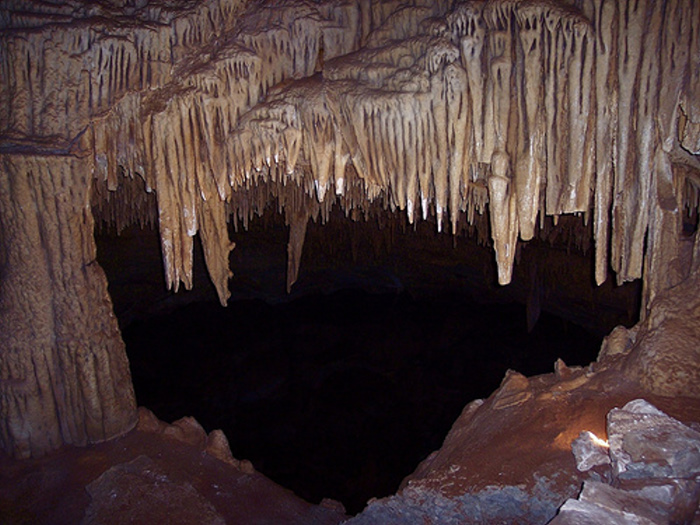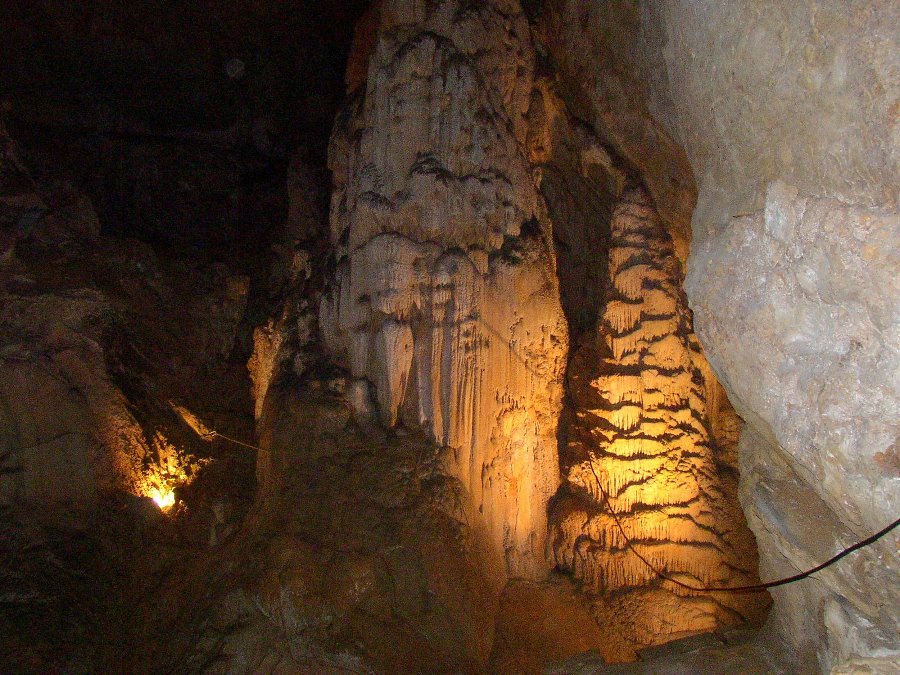|
Caves of the Midwest |
|||
|
Ruby Falls Chattanooga, TN ..
Ruby Falls is an 145-foot high underground waterfall located within Lookout Mountain, near Rock City and Chattanooga, Tennessee in the United States. The cave which houses Ruby Falls was formed with the formation of Lookout Mountain. About 200 to 240 million years ago (in the Carboniferous period, at the end of the Paleozoic era) the eastern Tennessee area was covered with a shallow sea, the sediments of which eventually formed limestone rock. About 200 million years ago, this area was uplifted and subsequent erosion has created the current topography. The limestone in which the cave is formed is still relatively horizontal, just as it was deposited when it was below sea level. The Lookout Mountain Caverns, which includes Ruby Falls Cave, is a limestone cave. These caves occur when slightly acidic groundwater enters subterranean streams and eats away at the relatively soft limestone, causing narrow cracks to widen into passages and caves in a process called chemical weathering. The stream which makes up the Falls entered the cave sometime after its formation. Ruby Falls Cave features many of the more well-known types of cave formations (or speleothems) including stalactites and stalagmites, columns, drapery, and flowstone. The Falls are located at the end of the main passage of Ruby Falls Cave, in a large vertical shaft. The stream, 1120 feet underground, is fed both by rainwater and natural springs. It collects in a pool in the cave floor and then continues through the mountain until finally joining the Tennessee River at the base of Lookout Mountain. While Ruby Falls Cave combines with Lookout Mountain Cave to form the Lookout Mountain Caverns, the two caves were not actually connected by any passage. Ruby Falls Cave is the upper of the two and contains a variety of geological formations and curiosities which Lookout Mountain Cave does not have. SOURCE: Wikipedia Ruby Falls ..
What exactly makes Ruby Falls
unique? Definitely has to be a waterfall. Don’t
say that you have seen
many waterfalls, and yes, even this Southerner
knows that Niagara Falls
is quite spectacular; however, this 145-foot
waterfall is located 1,120
feet beneath the mountain. - Source
What exactly makes Ruby Falls
unique? Definitely has to be a waterfall. Don’t
say that you have seen
many waterfalls, and yes, even this Southerner
knows that Niagara Falls
is quite spectacular; however, this 145-foot
waterfall is located 1,120
feet beneath the mountain. - Source
|
|||
|
The Caves of Tennessee The Lost Sea Sweetwater, TN ..
In Times Past Deep inside a mountain near Sweetwater in East Tennessee is a remarkable body of water known as The Lost Sea. Listed by the Guinness Book of World Records as America’s largest underground lake, the Lost Sea is part of an extensive and historic cave system called Craighead Caverns. The caverns have been known and used since the days of the Cherokee Indians. From the tiny natural opening on the side of the mountain, the cave expands into a series of huge rooms. Nearly a mile from the entrance, in a room now known as “The Council Room,” a wide range of Indian artifacts including pottery, arrowheads, weapons, and jewelry have been found, testifying to the use of the cave by the Cherokees. One of the cave’s earliest visitors was a giant Pleistocene jaguar whose tracks have been found deep inside the cave. Some 20,000 years ago the animal apparently lost his way in the darkness and wandered for days before plunging into a crevice far from the daylight he sought. Some of the bones, discovered in 1939, are now on display in the American Museum of Natural History in New York. Others, along with plaster casts of the tracks, are among the exhibits at the visitor center of the Lost Sea.
Ben Sands’ Discovery Throughout the early history there were consistent rumors of a large underground lake somewhere deep within the cave, but it was not actually discovered until 1905. In that year a 13-year-old boy named Ben Sands wiggled through the tiny, muddy opening 300 feet underground and found himself in a huge room half filled with water. The room was so large that his light was swallowed up by the darkness long before reaching the far wall or the ceiling. For the rest of his life Sands delighted in describing how he threw mudballs as far as he could into the blackness and heard nothing but splashes in every direction. The full extent of the Lost Sea is still not known despite the efforts of teams of divers armed with modern exploration equipment. The visible portion of the lake is 800 feet long by 220 feet wide. Glass-bottomed boats powered by electric motors carry visitors onto the lake, which is stocked with some of the largest Rainbow trout in North America. Fishing, incidentally, is not permitted. Beneath the calm waters of the four-and-a-half acre lake divers have discovered an even larger series of rooms completely filled with water. More than 13 acres of water have been mapped so far and still no end to the lake has been found. One diver ventured into the water-filled rooms with a sonar device. Hugging the wall to assure his ability to find his way back, he took soundings in all directions and found nothing but more water.
The Beginning of the Lost Sea Adventure In 1915 the idea of developing the cave for the public was conceived. A dance floor was installed in one of the large upper rooms. Cockfights were another frequent activity in the cave. Meanwhile, other portions of the vast system were being utilized by moonshiners to produce that famous brew for which the mountains are famous. The fascinating
history of Craighead Caverns provides
plenty of spice for tour guides as they lead groups
on the hike through
the immense rooms leading to the Lost Sea in the
deepest reaches of the
cave. Along the way visitors are treated to a wide
variety of interesting
formations including several displays of rare
crystalline structures called
"anthodites." These fragile, spiky clusters commonly
known as "cave flowers"
are found in only a few of the world’s caves. Their
abundance in Craighead
Caverns led the United States Department of the
Interior to designate the
Lost Sea as a Registered National Landmark, an honor
the Lost Sea shares
with such unique geological regions as the Cape
Hatteras National Seashore
in North Carolina and the Yosemite National Park in
California.
SOURCE: Lost Sea Official Home Page |
|||
|
The Caves of Tennessee Cumberland Caverns McMinnville, TN ..
Cumberland Caverns is Tennessee’s largest show cave We have educational tours, overnight spelunking tours, adventure tours, group tours, and banquets throughout the entire year. Something for everyone. Come Discover Tennessee's Underground.. SOURCE: Cumberland Caverns Home Page |
|||
|
The Caves of Tennessee Bristol Caverns Bristol, TN ..
Tennessee has over 8,000 known caves Beautiful and majestic Bristol Caverns! Far below the earth's surface, in the timeless beauty of Bristol Caverns, a strange and exciting experience awaits you. Paved, well lighted walkways wind through the vaulted chambers and along the banks of the ancient Underground River that carved these remarkable caverns from the hard core of the earth 200 to 400 million years ago. In the frontier days, Indians used the Underground River as an attack and escape route in their raids on settlers. Stealing into the area by way of the Underground River and the caverns, they swooped down on unsuspecting families, then disappeared as if swallowed up by the earth. You will be retracing the same warrior paths while exploring the vast rooms and arches, columns, and natural stone formations of varying size and kinds. These formations, millions of years old, display rich veins of minerals which give the formations beautiful colors of red, blue, gray, brown and sparkling white. SOURCE: Bristol Caverns Home Page |
|||
| FAIR USE NOTICE: This page contains copyrighted material the use of which has not been specifically authorized by the copyright owner. Pegasus Research Consortium distributes this material without profit to those who have expressed a prior interest in receiving the included information for research and educational purposes. We believe this constitutes a fair use of any such copyrighted material as provided for in 17 U.S.C § 107. If you wish to use copyrighted material from this site for purposes of your own that go beyond fair use, you must obtain permission from the copyright owner. | |||
|
|
